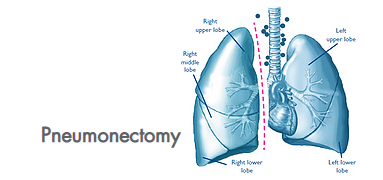Lung resection involves removal of part of the lung, either to remove a tumour or other abnormality, or to obtain a specimen of lung (biopsy) for diagnosis.
The most common types of resection are:
- Wedge resection — a wedge-shaped portion of lung tissue is removed, commonly for diagnostic purposes or to remove a small nodule or tumour.
- Lobectomy — one of the five lobes of the lungs (three on the right, two on the left) is removed, leaving the remaining lung to work as normal; this is the most common procedure performed for lung cancer, as it maximises the chance of removing not only the primary cancer but any microscopic spread that may have occurred prior to surgery.
- Pneumonectomy – an entire lung is removed, either because more than one lobe is involved by cancer or because the cancer involves the central part of the lung where it attaches to the heart and trachea.



